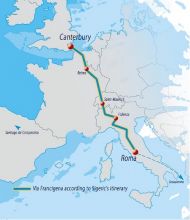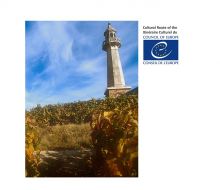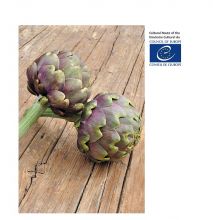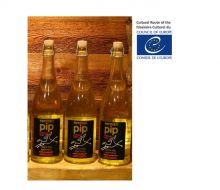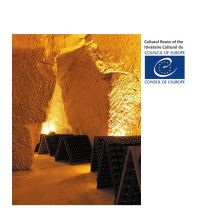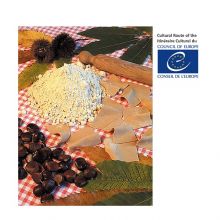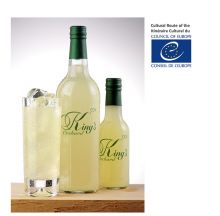The Via Francigena
It was 990 A.D. when Archbishop Sigeric wrote down the 79 stages of his journey "de Roma usque ad mare" (from Rome to the sea) during his way back from Rome to the Episcopal seat of Canterbury (Durovernum in Latin), his birthplace. In modern geography, the route crosses seven Italian regions – Latium, Tuscany, Emilia, Liguria, Lombardia, Piedmont and the Aosta Valley – and then proceeds beyond the Alps, through the Swiss cantons of Valais and Vaud; it then passes through Franche-Comté, Champagne-Ardenne, Picardie and Nord-Pas-de-Calais to finally cross the Channel and reach Canterbury, in the county of Kent.
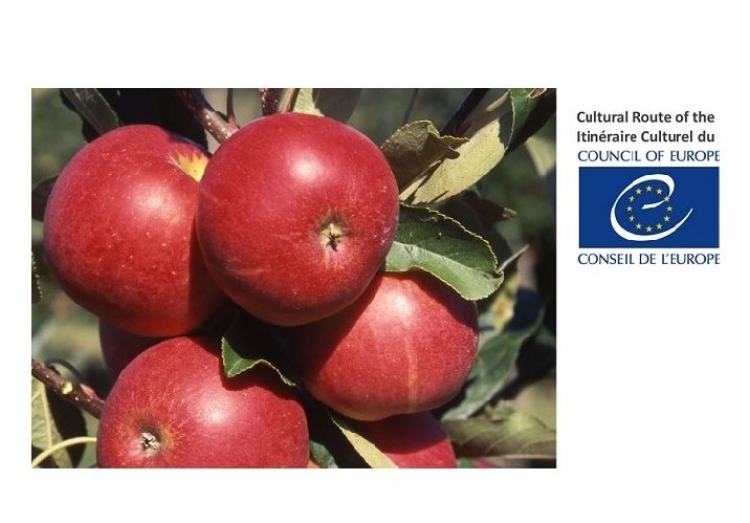
Details
| Countries and regions |
|
|---|---|
Description
Aware of the deep cultural and spiritual value of the ancient medieval route, and acting as a potential catalyst for the processes of local development based on sustainability, the Via Francigena has become a “cultural and tourist product”. The Via Francigena is a “multi-faceted cultural heritage”, deep-rooted in a thousand years of history; the Via Francigena has shaped itself through the centuries and through the passage of people: paths, slow roads necessarily in stages – which bordered not a single road but a group of roads – ancient meeting places for the citizens of modern Europe.
Regional products to be tasted along the route
Apples (UK). Kent has a long association with the cultivation of apples. The founding of the first, proper apple orchards was in the reign of King Henry VIII and Kent has been and remains the apple capital of the United Kingdom. Given its apple heritage, Kent has long been at the forefront of the development and introduction of new varieties close to those first ‘King’s orchards’. Kent’s acreage of apples is still grown extensively in the county’s two major fruit-belts. Orchards continue to dot the Kent landscape near Canterbury.
Kentish pip (UK). Cider is not easy! Apples have a whole range of differing characteristics that affect the final outcome, juiciness, acidity, sweetness and astringency (due to tannin) all of which affect flavour and drinkability. Other influences are yeasts, fermentation, maturation and the exclusion of air.
Les vins de champagne (France). Up until the Middle Ages, vineyards were tended by monks and wine was consecrated and taken as part of the holy mass. History comes together with geography to create a unique destiny for the wines of Champagne. Kings, princes and noblemen were the fi rst customers of champagne and were to become its best ambassadors. There is no shortage of anecdotes; when Charles VI met the King of Bohemia in the 14th century, the ideal conditions for the meeting are attributed to the diplomatic qualities of Champagne wines.
It all started with the ‘terroir’, that unique blend of land, climate and tradition, that was to engender the most original wines thanks to the talent of men, who were able to express the characteristic delicacy of the wine and then turn it into the sublime by making it sparkle. Ever since, champagne producers and Champagne Houses have been ceaselessly developing this know-how and heritage to share the presti gious ‘Appellation’ with as many as possible. On this particular land, historically linked to the vine, man has given birth to a unique wine envied by the whole world. The Champagne landscapes tell the story of this success. Not just the vineyards, but also the buildings of Champagne Houses and producers, vineyard shelters, press houses, cellars and chalk pits – all are witness to the special links which unite the men of Champagne with their land.
Cheese, Bread, Honey, Meat, Beverages (Switzerland). In the canton of Valais, after passing Martigny, the Via Francigena enters the Valley of the Dranse and runs through the six towns of the district of Entremont, which goes all the way to the Great St. Bernard Pass. The typical products described here below are marketed under the brand “La Corbeille d’Entremont”.
Cheese. Feathers in the cap of La Corbeille d’Entremont TM are several kinds of cheese such as Bagnes and Orsières – i.e. two kinds of raclette cheese–, tomme de Bruson, tomme de Vollèges and sérac. Each variety of cheese from Entremont gains prestige through its own territory of production. Connoisseurs have no doubts, it is wellknown that a soft and creamy raclette reminds of the varieties of flowers from high-altitude pasturelands and smells sweetly like hay.
Bread. The whole, homemade and traditional pain de seigle AOC (Controlled Designation of Origin rye bread) boasts a long tradition, and it suits well for modern flavour and nutritional needs.
Meat. Beef, pork, venison or mutton sausages, garlic flavoured or spicy, are the secret of our butchers, the legacy of an art passed from generation to generation. They are perfect for any occasion. The Saucisse de l’Entremont™, which meets high quality standards as far as the origin of raw materials is concerned, is the pride of our butchers. Finally, our ribs of alpine pasture lamb or our tender steaks of Hérens beef bring the delicious taste of alpine fl owers on your table.
Honey. All the flowers in one honey! Extracted from the heart of flowers, rich in virtues of the extraordinary rare plants that live in our valleys, the honey of Entremont is more than simple nourishment, a real feast of flavours, a panacea for our health.
Beverages. The wines of Entremont are well-known and appreciated everywhere, Gamay de Bovernier is vibrant, Gamaret de Vollèges is intense. Grapes are grown by the best winemakers and owners of the Canton of Valais. Our aromatic herbs, medicinal herbs and Alps tea are great discoveries, genuine products that are grown using organic and natural methods. Bio Alp Teas are a blend of aromatic plants and herbs, they are refreshing and low in sugar.
Chesnut flour of Lunigiana (Italy). This very fine flour is ivory or light beige in colour and is appreciated for its sweet taste and its persistent fragrance even after cooking. The high quality of such flour depends on the fine varieties of chestnut trees and on the very ancient processing techniques. The chestnut flour of Lunigiana boasts the national Protected Designation of Origin status thanks to its superior quality and to a century-long association with the cultivation of chestnuts and special processing techniques. The flour is extremely versatile in the cuisine and always keeps its special flavour, whether it is used to make tagliatelle and lasagne, to knead fritters and “castagnaccio” or to bake special bread. The production area covers the province of Massa Carrara.
“Romanesco” Artichoke. It has been grown in the countryside of Latium since the time of the Etruscans and has become very popular since the 15th century. There are two cultivars: Castellamare and Campagnano. At the “Bacchanalia Festival” held in Campagnano at the time of artichoke harvesting every year, the vegetable is barbecued on vine branches and seasoned with oil, fresh garlic and peppermint… really mouthwatering!
Gallery
Links of interest
| The Via Francigena Official Site |
| Facebook Fan Page |


 Italy
Italy  Switzerland
Switzerland  France
France  Great Britain
Great Britain 